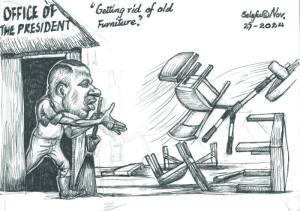In the heart of the vast Arabian desert, a vision emerged - a vision that would reshape the landscape and redefine the very essence of urban living. The Line construction project in Saudi Arabia, an ambitious endeavour that promised a revolutionary approach to city planning and sustainability, captured the imagination of the world.
The Line was conceived as a linear city, a ribbon of interconnected communities stretching 170 kilometers across the desert. The brainchild of Saudi Crown Prince Mohammed bin Salman, the project aimed to revolutionise the concept of urban living, addressing issues of sustainability, environmental impact, and the quality of life.
The futuristic proposal garnered attention for its boldness, promising a city where people could live, work, and thrive in a seamlessly integrated environment. At first glance, the Line appeared to be a marvel of innovation, a city designed for the future.
Its blueprint envisioned a string of connected communities, each housing around a million residents, with essential services, green spaces, and cutting-edge technology seamlessly woven into the fabric of everyday life. The linear design, according to proponents, would eliminate the need for cars and reduce commute times, fostering a sustainable, eco-friendly urban experience. On the positive side, the Line project held the potential to alleviate urban congestion, reduce carbon emissions, and create a blueprint for sustainable city development.
The focus on green spaces and a commitment to renewable energy sources underscored a dedication to environmental responsibility. Moreover, the implementation of advanced technologies, such as artificial intelligence and robotics, promised a city that would be on the cutting edge of efficiency and convenience. However, the grandeur of the Line construction project did not shield it from skepticism. As with any monumental undertaking, concerns and doubts lingered. Some questioned the feasibility of the linear design, arguing that it might result in disconnected communities, hindering the sense of unity that is integral to urban living.
The linear layout, although innovative, raised questions about the practicality of daily life, especially in a region known for its harsh desert conditions. Furthermore, critics pointed out potential challenges in terms of resource allocation and infrastructure development.
Building a linear city in the desert required massive investment not only in construction but also in sustaining a population with water, power, and other essential services.
The environmental impact of such a massive construction project also came under scrutiny, with concerns about habitat disruption, water usage, and the overall ecological balance of the region. One cannot help but wonder if a circular city design might have been a more efficient alternative.
The circular city concept has been praised for its ability to create a cohesive, well-connected community. In contrast to the linear approach, a circular city allows for a more centralised design, with efficient transportation, community hubs, and green spaces radiating outward from a central core.
The circular layout fosters a sense of unity and interconnectedness, addressing some of the potential pitfalls of a linear design. In considering the benefits of a circular design, one could argue that it promotes a more balanced distribution of resources.
With a centralised core, essential services and infrastructure could be more efficiently allocated, reducing the challenges associated with providing water, power, and other necessities to dispersed communities. The circular layout also encourages a more organic sense of community, fostering social bonds and a shared identity among residents.
Moreover, a circular design might better accommodate the natural contours of the desert landscape, minimising environmental disruption. The linear city, by contrast, could require significant alterations to the terrain, potentially leading to habitat destruction and long-term ecological consequences.
A circular city, designed to work in harmony with the environment, could offer a more sustainable and ecologically responsible alternative.
While the Line construction project showcases visionary thinking and a commitment to innovation, the question remains whether the linear design is the most pragmatic solution for sustainable urban living in the Arabian desert.
Could a circular city, with its potential for efficient resource allocation, enhanced community connectivity, and reduced environmental impact, have been a more thoughtful approach?
Ultimately, the success of the Line construction project will depend on meticulous planning, adaptable infrastructure, and a keen understanding of the unique challenges posed by the harsh desert environment. As the world watches the development of this ambitious endeavour, it serves as a compelling case study for the delicate balance between ground-breaking innovation and the practical considerations essential for creating lovable, sustainable cities. The future of the Line will unfold not just in its linear expanse but in its ability to stand as a beacon of forward-thinking urban planning, one that harmonises with both nature and the needs of its inhabitants.





